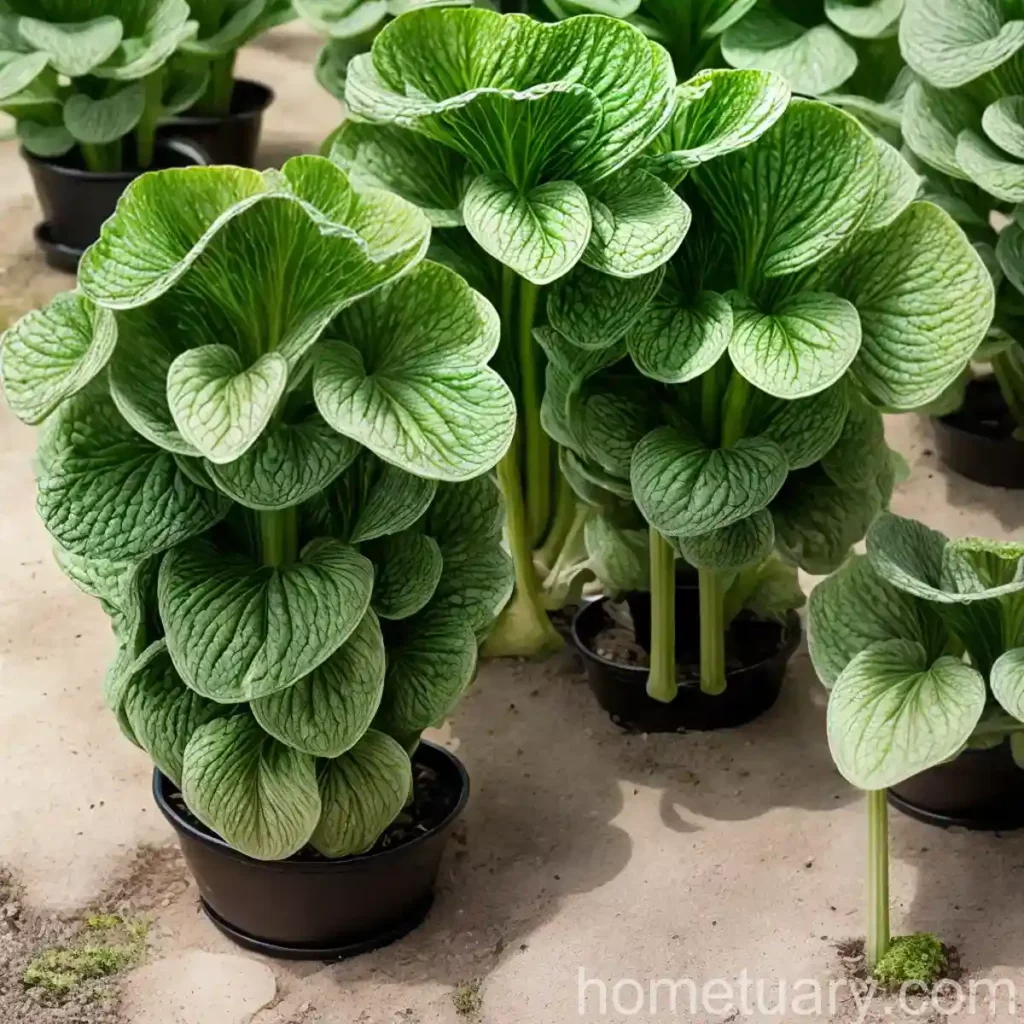Plant Name: Butterbur (Petasites japonicus)
What is Butterbur (Petasites japonicus)?
Butterbur, or Petasites japonicus, is a perennial flowering plant in the Asteraceae family, known for its large, heart-shaped leaves and pink or white flower clusters. Native to East Asia, including Japan, Korea, and China, butterbur has been used for centuries in traditional Asian medicine for its alleged health benefits. In recent years, it has gained attention in the field of complementary and alternative medicine for its potential medicinal properties.
Key Takeaways on Butterbur (Petasites japonicus)
- Scientific Name: Petasites japonicus
- Medicinal Uses: Butterbur is believed to provide relief from allergies, migraines, respiratory issues, menstrual cramps, urinary tract health, and skin conditions.
- Cultural Significance: Traditionally used in Asian medicine for its therapeutic potential.
- Research Interest: The plant is the subject of ongoing research to validate its claimed health benefits.
- Growing Conditions: Butterbur thrives in moist, shady environments and requires specific care to flourish.
Culture
Uses
Butterbur has a rich history of use in traditional medicine, particularly in East Asia, where it has been utilized for various therapeutic purposes. Some common uses of butterbur include:
- Allergy Relief: It is commonly used to alleviate symptoms of seasonal allergies and hay fever, potentially due to its anti-inflammatory properties.
- Migraine Management: Butterbur has been explored for its potential to reduce the frequency and severity of migraines.
- Respiratory Support: Traditional remedies often incorporate butterbur for respiratory health, particularly in addressing coughs and bronchitis.
- Menstrual and Urinary Health: It is believed to aid in relieving menstrual cramps and promoting urinary tract health.
- Skin Conditions: In some traditional applications, butterbur is used for skin-related issues.
Water
Butterbur requires consistently moist soil to thrive. Regular watering, especially during dry or warm periods, is essential for the plant’s health, as it prefers a damp environment.
Sunlight
This plant thrives in partial to full shade, making it well-suited for woodland gardens or shady areas in landscaping. It should be shielded from direct sunlight, especially during the hottest parts of the day.
Fertilizer
A balanced fertilizer can be applied in the spring to support healthy growth. Look for a formulation with equal proportions of nitrogen, phosphorus, and potassium to provide essential nutrients to the plant.
Soil
Butterbur prefers rich, fertile soil with good drainage. A slightly acidic to neutral soil pH (around 6.0 to 7.0) is generally suitable for optimal growth.
Pruning
Regular pruning can help maintain the plant’s size and shape, particularly to prevent it from spreading uncontrollably. Remove any dead or damaged foliage to promote overall plant health.
Propagation
Butterbur can be propagated through rhizome division or by collecting and planting its seeds. Division in early spring or fall allows for the creation of new plants from the parent rhizomes, while harvesting and sowing seeds offer an alternative propagation method.
Container Popularity
In regions where butterbur’s invasive potential poses a concern, some gardeners prefer to grow it in containers to restrict its growth. This allows individuals to enjoy the plant’s beauty while mitigating its potential for unchecked expansion.
Common Diseases
Butterbur generally exhibits good resistance to pests and diseases when grown in suitable conditions. However, it may still be susceptible to certain issues, including:
- Powdery Mildew: In high humidity, powdery mildew can develop on the leaves, leading to a white, powdery coating. Adequate air circulation and moisture management can help prevent this issue.
- Leaf Spot: Certain fungal pathogens can cause leaf spots, which manifest as discolored areas on the foliage. Removing and disposing of affected plant material can help control the spread of the disease.
Disease Diagnosis
If you notice unusual discoloration, spotting, or other irregularities on the leaves or stems of your butterbur plant, it is important to investigate and identify the cause promptly. Proper diagnosis of plant diseases can guide effective treatment strategies and prevent the issue from worsening.
Common Pests
While butterbur is relatively resistant to pests, occasional pest issues may arise. Common pests that can affect this plant include slugs and snails, which may feed on its foliage. Vigilance and the use of appropriate pest control measures can help manage these issues.
Botanist’s Tips
- Provide Ample Moisture: Butterbur thrives in consistently moist soil, so ensure that it receives sufficient water, especially during dry periods.
- Monitor Growth: Due to its invasive potential, particularly in ideal growing conditions, it is important to monitor and manage the plant’s growth to prevent it from spreading uncontrollably.
- Consider Container Gardening: Growing butterbur in containers can be an effective way to enjoy its ornamental appeal while containing its growth.
Fun Facts
- The large, heart-shaped leaves of butterbur lend a striking visual appeal to this plant, making it a popular choice for woodland and shade gardens.
- In traditional medicine, butterbur is valued for its purported health benefits and has been used for generations in various cultural contexts for therapeutic purposes.
Links to External Resources
For additional information on butterbur and its potential uses, refer to the following resources:
- Medicinal Uses of Petasites japonicus
- Butterbur for Allergies and Migraines
- Growing Tips for Butterbur
- Butterbur: A Traditional Herbal Remedy
In conclusion, butterbur (Petasites japonicus) is a fascinating and culturally significant plant with a history of use in traditional medicine. While its purported health benefits have garnered interest, it is essential to approach its use with caution and seek guidance from qualified healthcare professionals or horticulturists. By understanding the plant’s cultural significance, growing conditions, and potential uses, individuals can appreciate and explore the multifaceted aspects of butterbur. Whether admired for its ornamental qualities or valued for its traditional and potential medicinal properties, butterbur continues to captivate the interest of plant enthusiasts and researchers alike.















